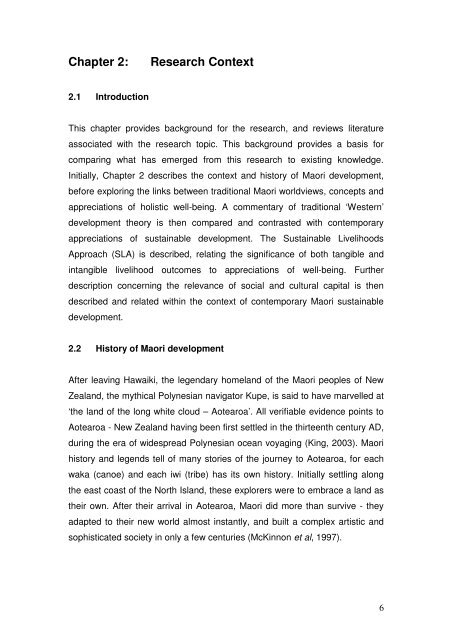Lincoln University Digital Dissertation - Lincoln University Research ...
Lincoln University Digital Dissertation - Lincoln University Research ...
Lincoln University Digital Dissertation - Lincoln University Research ...
Create successful ePaper yourself
Turn your PDF publications into a flip-book with our unique Google optimized e-Paper software.
Chapter 2: <strong>Research</strong> Context<br />
2.1 Introduction<br />
This chapter provides background for the research, and reviews literature<br />
associated with the research topic. This background provides a basis for<br />
comparing what has emerged from this research to existing knowledge.<br />
Initially, Chapter 2 describes the context and history of Maori development,<br />
before exploring the links between traditional Maori worldviews, concepts and<br />
appreciations of holistic well-being. A commentary of traditional ‘Western’<br />
development theory is then compared and contrasted with contemporary<br />
appreciations of sustainable development. The Sustainable Livelihoods<br />
Approach (SLA) is described, relating the significance of both tangible and<br />
intangible livelihood outcomes to appreciations of well-being. Further<br />
description concerning the relevance of social and cultural capital is then<br />
described and related within the context of contemporary Maori sustainable<br />
development.<br />
2.2 History of Maori development<br />
After leaving Hawaiki, the legendary homeland of the Maori peoples of New<br />
Zealand, the mythical Polynesian navigator Kupe, is said to have marvelled at<br />
‘the land of the long white cloud – Aotearoa’. All verifiable evidence points to<br />
Aotearoa - New Zealand having been first settled in the thirteenth century AD,<br />
during the era of widespread Polynesian ocean voyaging (King, 2003). Maori<br />
history and legends tell of many stories of the journey to Aotearoa, for each<br />
waka (canoe) and each iwi (tribe) has its own history. Initially settling along<br />
the east coast of the North Island, these explorers were to embrace a land as<br />
their own. After their arrival in Aotearoa, Maori did more than survive - they<br />
adapted to their new world almost instantly, and built a complex artistic and<br />
sophisticated society in only a few centuries (McKinnon et al, 1997).<br />
6
















